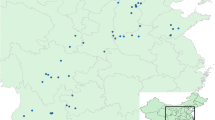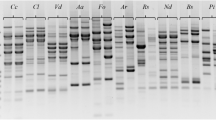Abstract
Genetic marker technology designed to detect naturally occurring polymorphisms at the DNA level had become an invaluable and revolutionizing tool for both applied and basic studies of fungi. To eliminate the confusion on the taxonomy of Ganoderma strains, in this study, a collection of 31 accessions representative of morphotypes and some unclassified types was used for analyzing molecular diversity using a novel molecular marker sequence-related amplified polymorphism (SRAP). This collection included commercial cultivars and wild varieties that represented the great diversification of types from different countries and regions. The experimental results showed that 50 out of 95 combinations of primers turned out to be polymorphic, and 85 polymorphism bands were obtained using six combinations. Based on the appearances of markers, the genetic similarity coefficients were calculated, and genetic variations were observed (0∼1) among the 31 different Ganoderma strains. The group of Ganoderma lucidum showed significant differences from the group of Ganoderma sinense. Moreover, G. lucidum in China was also different from G. lucidum in Yugoslavia. At the same time, cluster analysis successfully categorized these 31 Ganoderma strains into five groups. These results revealed the genetic diversity of Ganoderma strains and their correlation with geographic environments. It also suggested SRAP marker could be used in the taxonomic analysis of fungi. To our knowledge, this is the first application of SRAP marker on the systematics of Ganoderma strains within basidiomycetes.



Similar content being viewed by others
References
Chang R (1996) Functional properties of edible mushrooms. Nutr Rev 54:91–93
Ferriol M, Picó B, Nuez F (2003) Genetic diversity of a germplasm collection of Cucurbita pepo using SRAP and AFLP marker. Theor Appl Genet 107:271–282
Flores Berrios EP, Alba Gonzalez JF, Arrizon Gavino JP, Romano P, Capece A, Gschaedler Mathis A (2005) The uses of AFLP for detecting DNA polymorphism, genotype identification and genetic diversity between yeasts isolated from Mexican agave-distilled beverages and from grape musts. Lett Appl Microbiol 41:147–152
Gao Y, Tang W, Dai X, Gao H, Chen G, Ye J, Chan E, Koh HL, Li X, Zhou S (2005) Effects of water-soluble Ganoderma lucidum polysaccharides on the immune functions of patients with advanced lung cancer. J Med Food 8:159–168
Gonzalez P, Labarere J (2000) Phylogenetic relationships of Pleurotus species according to the sequence and secondary structure of the mitochondrial small-subunit RNA. Microbiology 146:209–221
Graham GC, Mayers P, Henry RJ (1994) A simplified method for the preparation of fungal genomic DNA for PCR and RAPD analysis. Biotechniques 16:49–50
Jaccard P (1908) Nouvelles recherches surla distribution florale. Bull Soc Vaudoise Sci Nat 44:223–270
Jiang Y, Wang H, Lu L, Tian GY (2005) Chemistry of polysaccharide Lzps-1 from Ganoderma lucidum spore and anti-tumor activity of its total polysaccharides. Yao Xue Xue Bao 40:347–350
Kimura Y (2005) New anticancer agents: in vitro and in vivo evaluation of the antitumor and antimetastatic actions of various compounds isolated from medicinal plants. In Vivo 19:37–60
Lee SY, Rhee HM (1990) Cardiovascular effects of mycelium extract of Ganoderma lucidum: inhibition of sympathetic of sympathetic outflow as a mechanism of its hypotensive action. Chem Pharm Bull 38:1359–1364
Li G, Quiros CF (2001) Sequence-related amplified polymorphism (SRAP), a new marker system based on a simple PCR reaction: its application to mapping and gene tagging in Brassica. Theor Appl Genet 103:455–461
Li G, Gao M, Yang B, Quiros CF (2003) Gene for gene alignment between the Brassica and Arabidopsis genomes by direct transcriptome mapping. Theor Appl Genet 107:168–180
Lin ZB (2001) Modern study on Ganoderma lucidum. Peking Medical Science University, Beijing
Lin ZX, Zhang XL, Nie YC (2004) Evaluation of application of a new molecular marker SRAP on analysis of F2 segregation population and genetic diversity in cotton. Acta Genetica Sinica 31:622–626
Nei M, Li WH (1979) Mathematical model for studying genetic variation in terms of restriction endonuclease. Proc Natl Acad Sci U S A 76:5269–5273
Ofodile LN, Uma NU, Kokubun T, Grayer RJ, Ogundipe OT, Simmonds MS (2005) Antimicrobial activity of some Ganoderma species from Nigeria. Phytother Res 19:310–313
Pezzuto JM (1997) Plant-derived anticancer agents. Biochem Pharmacol 53:121–133
Qi JJ, Ma RC, Chen XD, Lan J (2003) Analysis of genetic variation in Ganoderma lucidum after space flight. Adv Space Res 31:1617–1622
Royse DJ, May B (1982) Use of isozyme variation to identify genotypic classes of Agaricus brunnescens. Mycologia 74:93–102
Ryvarden L (1994) Can we trust morphology in Ganoderma. In: Buchanan PK, Hseu RS, Moncalvo JM (eds) Ganoderma: systematics, phytopathology and pharmacology. Proceedings of contributed symposium 59 A, B. Fifth International Mycological Congress, Vancouver, August 14-21, 1994, pp 19–24
Sokol S, Kaldorf M, Bothe H (1999) Molecular characterization and taxonomic affinities of species of the white rot fungus Ganoderma. Z Naturforsch 54:314–318
Su JM, Fu RH, Zhou JB, Zhang LH (2002) Applying practice of SPSS serial of statistics software: cluster analysis. Publishing House of Electronics Industry, Beijing
Toyomasu T, Takazawa H, Zennyoji A (1992) Restriction fragment length polymorphisms of mitochondrial DNAs from the basidiomycetes Pleurotus species. Biosci Biotechnol Biochem 56:359–361
Wang DM, Yao YJ (2005) Intrastrain internal transcribed spacer heterogeneity in Ganoderma species. Can J Microbiol 51:113–121
Wang SY, Hsu ML, Hsu HC, Tzeng CH, Lee SS, Shiao MS, Ho CK (1997) The anti-tumor effect of Ganoderma lucidum is mediated by cytokines released from activated macrophages and T lymphocytes. Int J Cancer 70:699–705
Zeng FY, Zhang YZ (1996) Preparation of edible fungus DNA from polysaccharide-rich sample. Acta Edulis Fungi 3:13–17
Acknowledgements
This work was financially supported by a grant from Science & Technology Department of Fujian Province, People’s Republic of China (2003EAT20021). We would like to sincerely thank Dr. Hu Zhu and Tianwen Wang of East China University of Science and Technology for their critical reading of the manuscript and useful suggestions.
Author information
Authors and Affiliations
Corresponding author
Rights and permissions
About this article
Cite this article
Sun, SJ., Gao, W., Lin, SQ. et al. Analysis of genetic diversity in Ganoderma population with a novel molecular marker SRAP. Appl Microbiol Biotechnol 72, 537–543 (2006). https://doi.org/10.1007/s00253-005-0299-9
Received:
Revised:
Accepted:
Published:
Issue Date:
DOI: https://doi.org/10.1007/s00253-005-0299-9




